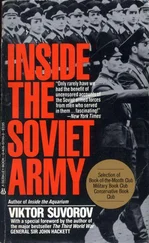Viktor Suvorov - Inside soviet military intelligence
Здесь есть возможность читать онлайн «Viktor Suvorov - Inside soviet military intelligence» весь текст электронной книги совершенно бесплатно (целиком полную версию без сокращений). В некоторых случаях можно слушать аудио, скачать через торрент в формате fb2 и присутствует краткое содержание. Год выпуска: 1984, ISBN: 1984, Жанр: Публицистика, Прочая документальная литература, на английском языке. Описание произведения, (предисловие) а так же отзывы посетителей доступны на портале библиотеки ЛибКат.
- Название:Inside soviet military intelligence
- Автор:
- Жанр:
- Год:1984
- ISBN:0-02-615510-9
- Рейтинг книги:3 / 5. Голосов: 1
-
Избранное:Добавить в избранное
- Отзывы:
-
Ваша оценка:
- 60
- 1
- 2
- 3
- 4
- 5
Inside soviet military intelligence: краткое содержание, описание и аннотация
Предлагаем к чтению аннотацию, описание, краткое содержание или предисловие (зависит от того, что написал сам автор книги «Inside soviet military intelligence»). Если вы не нашли необходимую информацию о книге — напишите в комментариях, мы постараемся отыскать её.
Inside soviet military intelligence — читать онлайн бесплатно полную книгу (весь текст) целиком
Ниже представлен текст книги, разбитый по страницам. Система сохранения места последней прочитанной страницы, позволяет с удобством читать онлайн бесплатно книгу «Inside soviet military intelligence», без необходимости каждый раз заново искать на чём Вы остановились. Поставьте закладку, и сможете в любой момент перейти на страницу, на которой закончили чтение.
Интервал:
Закладка:
The organisation of intelligence directorates (RUs) on the staffs of military districts, groups of forces, fronts and fleets is standardised. The intelligence directorate consists of five departments and two groups:
First Department or Department of Reconnaissance directs the activities of the reconnaissance units of the tactical wing, that is, reconnaissance battalions of divisions and reconnaissance companies of regiments. In naval terminology this department is called the Ship Reconnaissance Department. It directs the collection of information which comes directly from serving surface vessels and submarines at sea, bearing in mind that what is meant here are normal warships and not special intelligence collecting ships. The training of officers of First Departments is carried out in the intelligence faculty of the Frunze Military Academy and the corresponding faculty of the Naval Academy. The officers of First Departments are usually experienced army and navy officers who have considerable experience of service in reconnaissance units.
Second Department or Department of Agent Intelligence is concerned with the recruitment of secret agents and the obtaining through them of intelligence information of interest to the staff. The recruitment of agents and the creation of agent networks is carried out on the territories of contiguous countries where the military district concerned would expect to operate in war-time. Naval Intelligence is interested in recruiting agents from all territories, especially in large ports and naval bases. An intelligence centre and three or four intelligence points are subordinated to the Second Department which is directly concerned with agent work.
The centre is concerned with the recruitment of agents in the contiguous state, whereas the intelligence points only recruit agents in specific sectors and areas. They work independently from one another, although they are co-ordinated by the chief of the Second Department. The training of officers for work in the Second Departments and also in centres and points is carried out by the Third Faculty of the Military-Diplomatic Academy (the Academy of the Soviet Army).
The Third Department or Spetsnaz Department is concerned with the preparation and carrying out of diversionary acts on enemy territory, the liquidation of political and military leaders, the destruction of lines of communication and supply and the carrying out of terrorist operations with the aim of undermining the enemy's will to continue fighting. A Spetsnaz intelligence point is subordinated to this department and this carries out the recruitment of agent-terrorists on the territory of any possible future enemy. There is also a Spetsnaz brigade which consists of 1,300 cut-throat soldiers. The officers who work in the Spetsnaz intelligence points and those who direct their activities in the Third Department are trained, rather incongruously, in the Third Faculty of the Military-Diplomatic Academy, although for the Spetsnaz brigade and the officers connected with it training takes place in the Frunze Academy. Analogous organisations can be seen in the Navy, with this difference: the brigades are called Spetsnaz naval brigades (not to be confused with Naval infantry brigades) and the same 'diplomats' direct the activity of all agent-assassins in the fleets.
The Fourth Department or Information Department carries out the collection and collation of all intelligence coming into the intelligence directorate.
The Fifth Department is occupied with electronic intelligence, and this department directs two regiments, the Radio Intelligence Regiment and the Radio-Technical Intelligence Regiment. Radio Intelligence carries out the interception of radio signals and Radio-Technical Intelligence is concerned with tracking emissions from the enemy's radar.
The Intelligence Directorate Technical Facilities Group is occupied with the interpretation of air photographs. The training of specialists for such work is carried on at the Second Kharkov Higher Military Aviation and Engineering School.
The Interpreters' Group or 'the Inquisition' deals with the deciphering and translation of documents obtained, and with the interrogation of prisoners of war. Specialists for this group are prepared at the Military Institute (of Foreign Languages).
The Intelligence Department of the Army Staff
This may be seen as an intelligence directorate in miniature. It has very similar organisation: First Group or Reconnaissance Group: analogous to the First Department of an Intelligence Directorate and concerned with directing tactical reconnaissance, the difference being that it is only responsible for the divisions of one army, whereas the First Department of an Intelligence Directorate is responsible for all the divisions of its military district; Second Group or Secret Intelligence Group; Third Group or Spetsnaz Group: responsible for terrorist acts in the area of operations of its army - a specialist company of 115 cut-throat soldiers is part of it; Fourth Group Informational; Fifth Group which commands two battalions, radio intelligence and radio-technical intelligence -the Intelligence Department likewise has its own interpreters.
It would be a mistake to think that operational agent intelligence is a kind of second-class citizen compared with strategic intelligence. Every intelligence directorate is a kind of GRU in miniature with its electronic facilities, information services, secret agents and even, where the fleet is concerned, its independent cosmic service. During the course of a war, or immediately before war breaks out, the power of an intelligence directorate is immeasurably increased by the infiltration in the enemy's rear of thousands of Spetsnaz saboteurs. The intelligence directorates taken altogether form a very powerful intelligence conglomerate, in no way inferior in its scope to strategic intelligence. In other words the GRU, in the form of strategic and operational intelligence, has created two agent networks independent of one another and each duplicating the other. In countries like Norway, Sweden, West Germany, Austria, Turkey, Afghanistan and China the operational intelligence agent network by far exceeds strategic intelligence in strength, effectiveness and invulnerability. This can be confirmed by examining the task of the different intelligence directorates:
Northern Fleet - covering Norway, Great Britain, France, Spain, Portugal, Canada and the USA. There is no doubt that Northern Fleet intelligence is mainly restricted to targets on the sea shore or coastline, although this certainly does not preclude deep agent penetration of the whole territory of the country being investigated, including the central government organs.
Baltic Fleet - covering Sweden, Denmark, West Germany.
Black Sea Fleet - covering Turkey and the whole Mediterranean coastline.
Pacific Fleet - covering the USA, Japan, China, Canada and all countries of the Pacific Basin.
Leningrad Military District - Norway and Sweden. Agent intelligence work is not carried out on Finnish territory, since this country is well inside the Soviet sphere of influence, and its behaviour pleases the Kremlin much more than that of certain Warsaw pact countries, for example, Romania.
Baltic Military District - Sweden, Denmark.
Soviet Groups of Forces in Germany, the Northern Group of Forces in Poland, the Byelorussian Military District - all are concerned with the study of the German Federal Republic.
Central Group of Forces in Czechoslovakia - covering the German Federal Republic and Austria.
Southern Group of Forces in Hungary - Austria.
Carpathian Military District - covering Greece and Turkey from Bulgarian territory.
Kiev and Odessa Military District - Turkey, Austria.
Trans-Caucasian Military District Turkey, Iran.
Turkestan Military District - Iran, Afghanistan.
Читать дальшеИнтервал:
Закладка:
Похожие книги на «Inside soviet military intelligence»
Представляем Вашему вниманию похожие книги на «Inside soviet military intelligence» списком для выбора. Мы отобрали схожую по названию и смыслу литературу в надежде предоставить читателям больше вариантов отыскать новые, интересные, ещё непрочитанные произведения.
Обсуждение, отзывы о книге «Inside soviet military intelligence» и просто собственные мнения читателей. Оставьте ваши комментарии, напишите, что Вы думаете о произведении, его смысле или главных героях. Укажите что конкретно понравилось, а что нет, и почему Вы так считаете.












